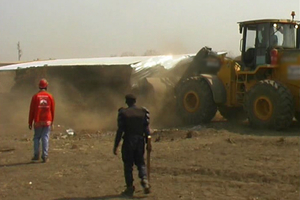By Delly Mawazo, a human rights lawyer and researcher on the DRC for Amnesty International
Exactly five years ago today, life came to an abrupt standstill for the people of Kawama in Katanga province.

Hundreds of families woke up to a rude interruption: bulldozers and menacing police poised to destroy their homes and evict them.
There had been no prior warning – just the sudden influx of bulldozers into Kawama. In the blink of an eye, the chaos of arbitrary demolition ensued.
For two agonizing days, residents of different neighbourhoods in Kawama watched helplessly as their homes were reduced to rubble. Their protests were ignored. Lives were disrupted, property destroyed and livelihoods lost.
The demolitions were carried out under the supervision of the Congolese national police with bulldozers and drivers from the Entreprise Générale Malta Forrest (EGMF). EGMF, which operated the Luiswishi mine next to Kawama, is a subsidiary of the Belgian Company Groupe Forrest International.
Groupe Forrest International claimed that creuseurs who had moved to Kawama weeks before the demolitions were stealing minerals from the Luiswishi mine. It had asked the authorities to intervene to address the theft of minerals. However, the police operation on 24 November led to the destruction of the homes of creuseurs without warning or due process – already a violation of Congolese, African and international law. But it went much further than that, also destroying at least 387 homes and businesses of Kawama’s permanent residents.
Today, five years on, the victims of the demolitions and forced evictions at Kawama are still awaiting compensation. Their efforts to seek justice have been undermined by Groupe Forrest International’s repeated denials that the villagers’ homes and businesses were demolished.
Amnesty International has launched a new report: Bulldozed: How a mining company buried the truth about forced evictions in the Democratic Republic of the Congo. It presents new evidence, including satellite imagery, exposing the scale of the demolitions and demonstrating that the company lied about the extent and impact of what happened at Kawama. Last month, Amnesty International presented this evidence to Groupe Forrest International, which no longer denies that villagers were affected, but it continues to deny any responsibility for the events.
Amnesty International is calling for Groupe Forrest International to pay compensation to the villagers for all of their losses. It is also calling on the Congolese authorities to ensure that there is justice and accountability.
The plight of the forcibly evicted Kawama villagers amounts to a gross violation of human rights. As a human rights lawyer and activist at Amnesty International, I am supporting the villagers in their fight to bring to account those who caused their misery.
The evicted villagers told me how the destruction of their homes and businesses brought the anguish of homelessness, disruption of education for schoolchildren and deeper poverty.
Sadly, compensation for the victims of Kawama has been as elusive as the justice they seek.
Whilst the Congolese justice system should have provided them justice, the criminal investigation into the case by the Avocat Général of Lubumbashi has not resulted in a trial. In fact, the Avocat Général working on the case was instructed by superiors not to bring charges.
Five years later, the victims of the Kawama demolitions are still waiting. Justice, so far, has been denied.
Kawama is richly endowed with minerals and other natural resources; these should be a source of access to employment and funding for social services rather than a trigger of conflicts and human rights abuses such as forced evictions.
Even now, the villagers face the threat of further forced evictions. EGMF pulled out from the mining concession in 2012. The company that owns the Luiswishi mine, Sociéte Minière du Sud-Katanga (CMSK) – now owned by the State-owned company Gécamines, has complained to the government about the renewed activities of creuseurs. In turn, the government has again threatened villagers in part of Kawama with demolition of their homes unless they ensure the creuseurs leave.
The authorities must refrain from issuing threats of repeated demolitions in Kawama – these would constitute collective punishment, wholly prohibited under international law.
CMSK has not taken any public steps to protest against these threats or to request that interventions by public security forces linked to its operations comply with human rights standards. Clearly, it has not learned the lessons from the 2009 demolitions.
The Congolese authorities, especially the police, have a responsibility to safeguard and protect the vulnerable communities of Kawama instead of violating their rights.
With the help of the authorities, the mining companies still operating in Kawama carry on as if it’s business as usual. But for the people who lost everything on those two fateful days of 24 and 25 November 2009, life will never be the same again.
Until there is full accountability and protection of their rights, the suffering of the inhabitants of Kawama will be far from over.
This op-ed originally appeared (in French) in Le Potential.
Read more:
DRC: Belgian mining giant lied over bulldozing homes (News story/report, 24 November 2014)

